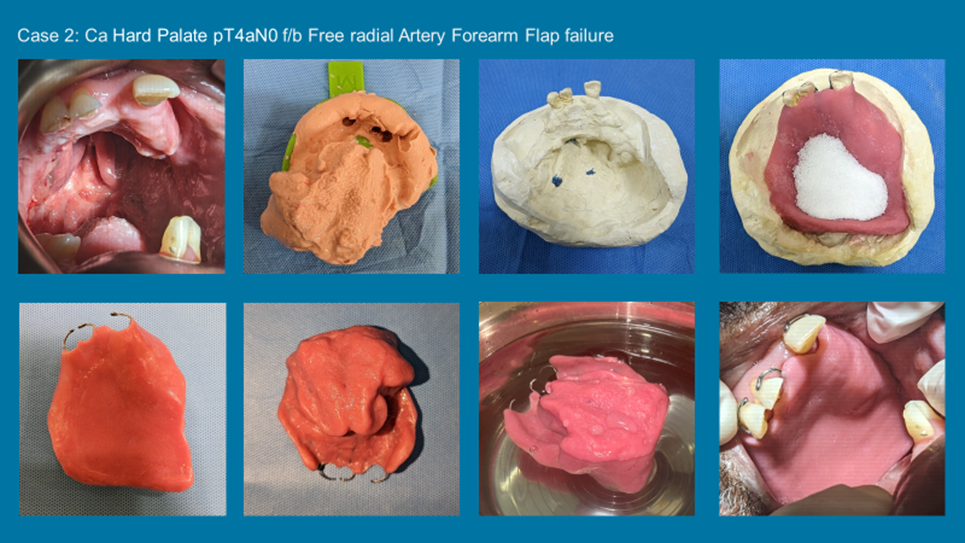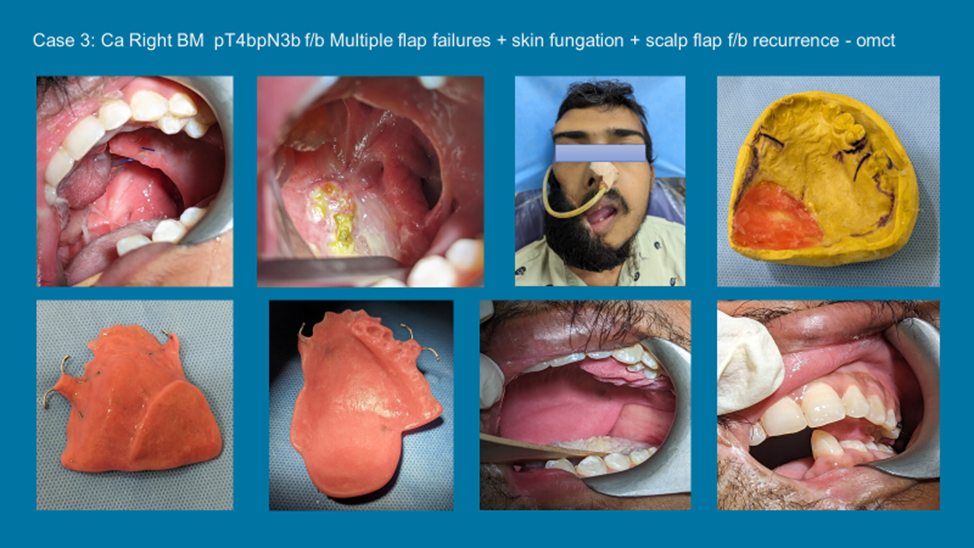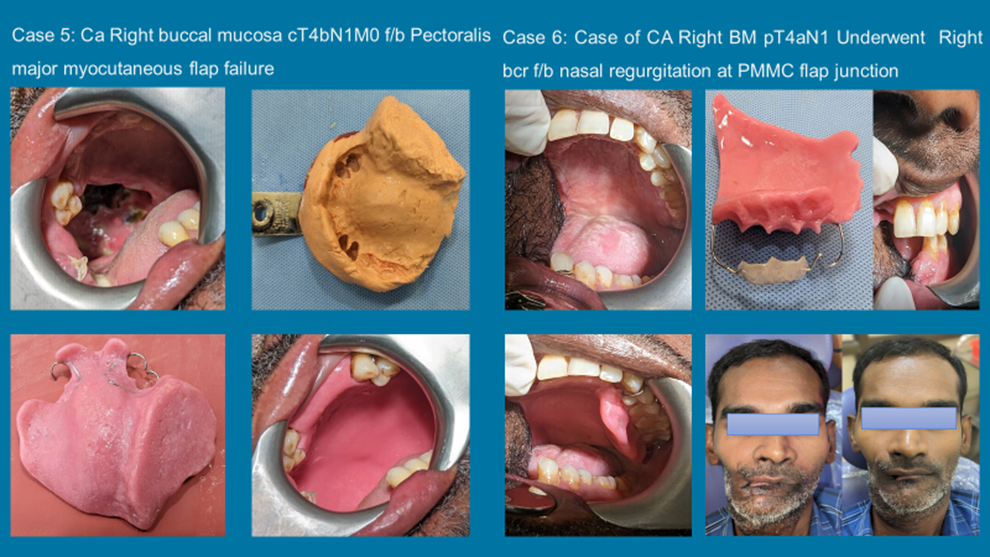Reviving Functionality and Quality of Life: Patient Centric Prosthodontic Management for Flap Failure in Head and Neck Oncology using Interim Obturators - A Case Series
Reviving Functionality and Quality of Life: Patient Centric Prosthodontic Management for Flap Failure in Head and Neck Oncology using Interim Obturators - A Case Series
Sauptik Ray1, Pankaj Chauhan2, Sandeep Gurav3, Madhumaitri Patra4, Ashish Yadav5, Bhushan Mistri6
1,4 Fellow; Department of Dental and Prosthetic Surgery, Tata Memorial Hospital, Mumbai, India.
2 Professor; Department of Dental and Prosthetic Surgery, Homi Bhabha Cancer Hospital & Research Centre, Vishakhapatnam, India.
3 Professor; Department of Dental and Prosthetic Surgery, Tata Memorial Hospital, Mumbai, India
5,6 Dental Technician; Department of Dental and Prosthetic Surgery, Homi Bhabha Cancer Hospital & Research Centre, Vishakhapatnam, India.
*Correspondence to: Dr Sauptik Ray; Department of Prosthodontics and Crown and Bridge, Manipal College of Dental Sciences Manipal, Karnataka, India.
Copyright.
© 2025 Dr. Sauptik Ray. This is an open access article distributed under the Creative Commons Attribution License, which permits unrestricted use, distribution, and reproduction in any medium, provided the original work is properly cited.
Received: 31 Jan 2025
Published: 05 Feb 2025
DOI: https://doi.org/10.5281/zenodo.14880812
ABSTRACT
This case series delves into the realm of prosthodontic strategies aimed at revitalizing patient comfort, functional capabilities, and overall quality of life in cases of flap failure within the domain of head and neck oncology. Through the analysis of clinical cases, this poster underscores the effectiveness of prosthodontic strategies integrating obturators for mitigating the consequences of flap failure. By effectively harnessing prosthodontic strategies involving obturators, patients can experience not only functional restoration but also a renewed sense of well-being in the aftermath of flap failure following head and neck oncology procedures.
Key words: flap, obturator, quality of life.
Reviving Functionality and Quality of Life: Patient Centric Prosthodontic Management for Flap Failure in Head and Neck Oncology using Interim Obturators - A Case Series
Background and Aim
Surgical intervention in Head and neck cancer often results in functional and aesthetic deficits. To address these issues, surgical reconstruction with flaps has become a standard treatment approach. Unfortunately, flap failure remains a possible unfortunate complication, leading to substantial morbidity, significantly impeding functional abilities and a decline in the patient's quality of life. [1]
Flap failure in head and neck oncology can result from various factors, including compromised vascular supply, infection, radiation therapy, and patient-specific factors. When flap failure occurs, it not only jeopardizes wound healing but also impacts speech, mastication, swallowing, and facial aesthetics. Therefore, a comprehensive and patient-centric approach to managing flap failure is essential to restore functionality and improve the overall well-being of these individuals.
Using interim obturators to address flap failure seeks to enhance functionality by restoring speech, mastication, and swallowing functions. It minimizes morbidity by reducing the need for additional surgical procedures and offering a non-invasive and efficient prosthodontic solution and improve the overall well-being of patients by addressing the physical, psychological, and social consequences thus promoting their return to a normal life. [2,3]
Case Report
This case series delves into the realm of prosthodontic strategies aimed at revitalizing patient comfort, functional capabilities, and overall quality of life in cases of flap failure within the domain of head and neck oncology. Flap failure, an unfortunate complication arising from surgical interventions, can significantly impede patient well-being and functional abilities. This highlights the pivotal role of prosthodontic interventions, specifically through the utilization of obturators, in addressing this challenge.
This case series compromises of six different cases of head and neck carcinoma which were subjected to single or multiple flap failures and finally rehabilitated by prosthodontic intervention.
In the first case, following submental flap failure in a case of carcinoma palate immediate implants were placed and an implant retained interim obturator was fabricated. One-year post radiation therapy an implant supported definitive obturator with complete denture was fabricated. (Case 1 - Fig 1)
Fig 1
Free Radial Artery Forearm flap (FRAFF) failure in another case of carcinoma hard palate resulted a huge maxillary posterior defect extending up to pharyngeal wall was restored using a light weight hollow bulb obturator in the following case. (Case 2 - Fig 2)
Fig 2
In a palliative case of carcinoma buccal mucosa suffering multiple flap failure, skin fungation, scalp flap followed by recurrence the patient was shifted to nasogastric feed. An interim maxillary obturator with guide bite prosthesis helped the patient to resume oral feed and improved speech intelligibility. (Case 3 - Fig 3)
Fig 3
Anterolateral thigh flap (ALT) failure in a case of osteogenic sarcoma of maxilla resulting in an extensive defect was restored with an interim obturator and the patient could be shifted to oral feed and there was remarkable improvement in speech. (Case 4 – Fig 4)
Fig 4
In the next two cases of carcinoma buccal mucosa, perctoralis major myocutaneous (PMMC) flap failure led to defects which were rehabilitated with interim obturators improving the quality of life of the patients. (Case 5,6 – Fig 5)
Fig 5
Discussion
The obturator prosthesis offers immediate and sustained benefits by ameliorating issues such as naso-gastric feeding, impaired deglutition, speech impairment, impaired mastication, and compromised esthetics. Tailored to individual patient needs, obturators play a pivotal role in restoring oral function and psychological equilibrium during the aftermath of flap failure. [4]
By addressing complications like wound dehiscence, oro-nasal communication, and compromised oral competence, this approach significantly contributes to enhanced patient outcomes and an overall elevated quality of life. Moreover, this accentuates the importance of interdisciplinary collaboration among surgeons, prosthodontists, and other healthcare professionals in optimizing patient care. [3,4]
Obturator rehabilitation is an essential component of end-of-life support for head and neck oncology patients who have undergone surgical resection of tumors that resulted in significant defects in their oral and maxillofacial region. Here are some important considerations for obturator rehabilitation in end-of-life support for head and neck oncology patients:[3,4,5]
- Oro-nasal Communication closure: Obturators effectively creates a seal, restoring the separation between the oral and nasal cavities, thereby improving speech and swallowing function.
- Improved Nutritional Intake: Obturators can facilitate eating by improving mastication & deglutition, thereby supporting adequate nutritional intake.
- Enhanced Speech Articulation: It serves as speech aids by allowing for better control of airflow and articulation of speech sounds significantly enhancing the patient's ability to communicate
- Pain Management: It provides relief by covering tissue defects and protecting sensitive areas & can be designed with comfortable materials minimizing friction & pressure on the surrounding tissues
- Oral Hygiene Maintenance: Obturators help in maintaining oral hygiene, essential to prevent oral infections and discomfort by sealing off defects, reducing the risk of food debris and bacteria entering the nasal cavity and causing infection.
- Psychological and Emotional Support: Appearance and the ability to speak and eat are deeply connected to a person's self-esteem and emotional well-being which are enhanced by obturators.
- Customization to Individual Needs: Obturators ensure optimal support tailored to the patient's unique condition taking into account their specific anatomical and functional requirements.
- Comfort and Quality of Life: Obturators address functional issues and help patients maintain a better quality of life.
Conclusion
By customizing obturators to meet each patient's unique needs, prosthodontists can play a pivotal role. Reviving functionality and quality of life is not just a medical intervention but a holistic approach & implementation of patient-centric prosthodontic management for flap failure using interim obturators represents a beacon of hope for patients facing these challenging circumstances. It is a testament to the dedication of healthcare professionals to improve the lives of individuals affected by head and neck cancer, ultimately offering them a chance at a brighter outlook and improved quality of life.
References
1. Zhou, W., Zhang, W.B., Yu, Y., Wang, Y., Mao, C., Guo, C.B., Yu, G.Y. and Peng, X., 2017. Risk factors for free flap failure: a retrospective analysis of 881 free flaps for head and neck defect reconstruction. International journal of oral and maxillofacial surgery, 46(8), pp.941-945. ?
2. Crawley, M.B., Sweeny, L., Ravipati, P., Heffelfinger, R., Krein, H., Luginbuhl, A., Goldman, R. and Curry, J., 2019. Factors associated with free flap failures in head and neck reconstruction. Otolaryngology–Head and Neck Surgery, 161(4), pp.598- 604. ?
3. Lim, B.J., Shin, J.Y., Roh, S.G., Lee, N.H. and Chung, Y.K., 2023. Clinical analysis of factors affecting the failure of free flaps used in head and neck reconstruction. Archives of Craniofacial Surgery, 24(4), pp.159-166.
4. Dholam, K.P., Bachher, G. and Gurav, S.V., 2020. Changes in the quality of life and acoustic speech parameters of patients in various stages of prosthetic rehabilitation with an obturator after maxillectomy. The Journal of Prosthetic Dentistry, 123(2), pp.355-363. ?
5. Dholam, K.P., Bachher, G.K., Yadav, P.S., Quazi, G.A. and Pusalkar, H.A., 2011. Assessment of quality of life after implant-retained prosthetically reconstructed maxillae and mandibles postcancer treatments. Implant Dentistry, 20(1), pp.85-94.

Figure 1

Figure 2

Figure 3

Figure 4

Figure 5
